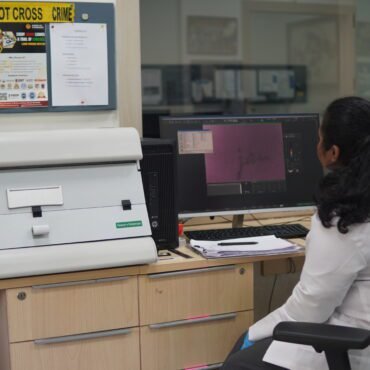Introduction
Forensic document analysis has been a cornerstone of criminal investigations and legal proceedings. Traditionally, forensic experts meticulously examined handwriting, signatures, and other textual evidence to establish authenticity or to detect forgery.
The incorporation of artificial intelligence (AI) in the field of forensic science ushered in a new era of accuracy as well as effectiveness in the examination of questioned documents. AI is transforming the way experts evaluate and authenticate documents through machine learning and advanced algorithms. This blog focuses on the groundbreaking advances, challenges, and potential influence of AI on document analysis.
Understanding Document Analysis and the Role of AI
Before getting into the role of AI in the analysis of documents, let us first define document analysis. The technique of extracting relevant information from written or visual documents is referred to as document analysis. This can comprise printed content, handwritten notes, pictures, PDFs, and various other kinds of files. The goal is to enhance the accessibility, searchability, and utility of these documents.
AI document analysis uses artificial intelligence (AI) methods such as the use of Machine Learning (ML), Natural Language Processing (NLP), Automation and Robotics, and Machine Vision (MV) to analyze the documents. Organizations can easily analyze their documents by applying these techniques in a matter of minutes, a process that might take several hours or days if accomplished manually.
AI’s Potential in Document Analysis
AI systems are highly skilled at recognizing complicated stroke patterns, variations in pressure, and other subtle handwriting characteristics. In cases of verification of signatures and analysis of handwriting, machine learning algorithms can recognize and categorize these variations more consistently and precisely than the human eye, resulting in more reliable findings.
- Automated Alteration Detection
One of the significant challenges in document analysis is detecting tampering or alterations. AI models are trained to identify consistent ink patterns and detect discrepancies that might indicate forged or manipulated content. The AI’s ability to process vast amounts of data enables it to pinpoint even the smallest irregularities, saving time and enhancing accuracy.
- Natural Language Processing (NLP)
The combination of AI with NLP (Natural Language Processing) enables the analysis of linguistic aspects in documents. AI can assist specialists in determining the authenticity or detecting inconsistencies by comparing the syntax, style, and language of a questioned writing to known examples. This is especially useful when it comes to authorship identification and validating the original source of written material.
- Optical Character Recognition (OCR)
AI-powered OCR technology can turn printed or handwritten content from scanned papers into machine-readable text. This facilitates the digitization and search through a large number of physical documents.
- Categorization and classification
Documents can be classified by AI into predetermined categories or subjects. It can, for example, organize emails into folders, legal documents by case type, and research papers by topic area. This makes organizing documents and retrieval easier.
- Image and multimedia analysis
AI can assess the authenticity of images and multimedia content, uncovering manipulations or tempering that could impact the evidential value of documents.
Artificial intelligence can extract structured information from unstructured documents. For instance, it can collect information that includes names, dates, and addresses from bills, forms, or resumes, saving endless hours of manual data entry.
AI excels in detecting alterations, forgeries, tampering in documents, and identifying inconsistencies in ink, layout, or typography.
- Document metadata analysis
AI can scrutinize metadata associated with digital documents, revealing crucial information about their, origin, editing history, and distribution.
In cases involving shredded or damaged documents, AI can assist in digitally reconstructing and aligning fragments for analysis.
Challenges and Ethical Considerations
AI models are only as good as the data on which they are trained. Skewed outcomes might result from biased or inadequate datasets. To provide fair and reliable analysis across various demographics, it is critical to curate varied and representative datasets.
While artificial intelligence improves productivity, it is critical to create a balance between AI-assisted analysis and human expertise. Human analysts add context, subject knowledge, and critical thinking to the process, assuring well-founded and comprehensive results.
AI models are only as good as the data on which they are trained. High accuracy in document analysis can often require extensive training data and fine-tuning.
The use of AI for handling sensitive documents raises concerns regarding data privacy and security. It is critical to protect confidential data.
It might be difficult to integrate AI-powered document analysis tools with existing workflows and applications.
Personal or sensitive information may be included in document analysis, requiring strict moral considerations and compliance with rules such as GDPR (General Data Protection Regulation).
The Future Landscape
AI advancements, such as transfer learning and generative models, will lead to even more accurate and sophisticated document analysis. AI models will improve their ability to adapt to new document kinds and variations, enhancing forensic professional’s overall capabilities.
- Historical Document Insights
The ability of AI to process massive numbers of historical records has the potential to reveal hidden insights and trends. Experts can obtain a better understanding of historical periods and persons by analyzing language changes, writing techniques, and contextual circumstances.
To protect sensitive information, there will be more emphasis on privacy-preserving AI in the analysis of documents. Techniques like federated learning and secure computation will be integrated into AI systems to protect the privacy of individuals mentioned in documents.
With the advancement of AI, there will be a growing emphasis on explainable AI models to provide transparent and understandable results, which are very crucial for presenting evidence in legal proceedings.
AI may be used to verify the authenticity of digital documents through blockchain technology ensuring tamper-proof records.
Conclusion
The incorporation of artificial intelligence into document analysis has revolutionized the sector, improving accuracy and efficiency, and more accessible than ever before. AI-driven document analysis not only saves time and resources but also improves decision-making processes across various industries. We should expect even more powerful and innovative applications in this field of study as AI and machine learning keep developing.
However, it is essential to consider ethical and privacy implications when implementing AI in document analysis to ensure responsible and secure data handling.
While challenges like bias and human-AI collaboration persist, the potential for AI to assist experts in making more informed decisions is undeniable. As AI advances, forensic experts and AI technology will work together to discover the truth behind disputed documents, ensuring justice and authenticity prevail.
As AI technologies continue to advance, they will undoubtedly play a greater role in upholding justice and integrity in court proceedings, all while resolving ethical and privacy concerns associated with the digital era.
References
- Automation USA. (2020). Analyzing documents faster using artificial intelligence from Fraunhofer. [online] Available at: https://usa-automation.net/news/30663-analyzing-documents-faster-using-artificial-intelligence-from-fraunhofer [Accessed 9 Oct. 2023].
- https://kodzilla.pl and Sofiia (2023). Addepto. [online] Addepto. Available at: https://addepto.com/blog/how-ai-is-revolutionizing-document-analysis-a-comprehensive-guide/.
- Marinai, S., Gori, M. and Soda, G. (2005). Artificial neural networks for document analysis and recognition. IEEE Transactions on Pattern Analysis and Machine Intelligence, 27(1), pp.23–35. doi:https://doi.org/10.1109/tpami.2005.4.





Post comments (0)